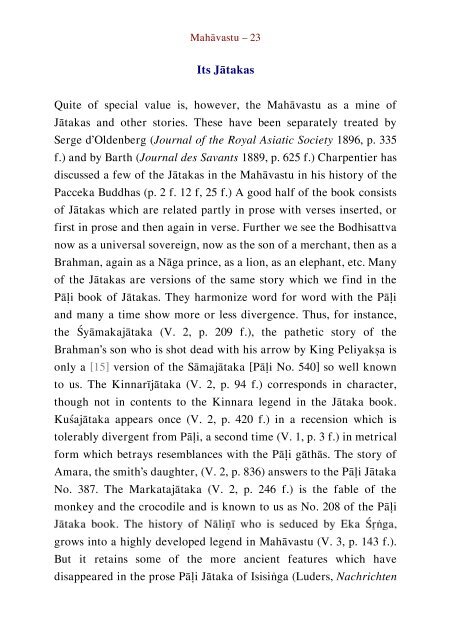Literary History of Sanskrit Buddhism
A study by J. K. Nariman of Sanskrit Buddhism from the Early Buddhist Tradition up to the Mahayana texts proper.
A study by J. K. Nariman of Sanskrit Buddhism from the Early Buddhist Tradition up to the Mahayana texts proper.
You also want an ePaper? Increase the reach of your titles
YUMPU automatically turns print PDFs into web optimized ePapers that Google loves.
Mahāvastu – 23<br />
Its Jātakas<br />
Quite <strong>of</strong> special value is, however, the Mahāvastu as a mine <strong>of</strong><br />
Jātakas and other stories. These have been separately treated by<br />
Serge d’Oldenberg (Journal <strong>of</strong> the Royal Asiatic Society 1896, p. 335<br />
f.) and by Barth (Journal des Savants 1889, p. 625 f.) Charpentier has<br />
discussed a few <strong>of</strong> the Jātakas in the Mahāvastu in his history <strong>of</strong> the<br />
Pacceka Buddhas (p. 2 f. 12 f, 25 f.) A good half <strong>of</strong> the book consists<br />
<strong>of</strong> Jātakas which are related partly in prose with verses inserted, or<br />
first in prose and then again in verse. Further we see the Bodhisattva<br />
now as a universal sovereign, now as the son <strong>of</strong> a merchant, then as a<br />
Brahman, again as a Nāga prince, as a lion, as an elephant, etc. Many<br />
<strong>of</strong> the Jātakas are versions <strong>of</strong> the same story which we find in the<br />
Pāḷi book <strong>of</strong> Jātakas. They harmonize word for word with the Pāḷi<br />
and many a time show more or less divergence. Thus, for instance,<br />
the Śyāmakajātaka (V. 2, p. 209 f.), the pathetic story <strong>of</strong> the<br />
Brahman’s son who is shot dead with his arrow by King Peliyakṣa is<br />
only a [15] version <strong>of</strong> the Sāmajātaka [Pāḷi No. 540] so well known<br />
to us. The Kinnarījātaka (V. 2, p. 94 f.) corresponds in character,<br />
though not in contents to the Kinnara legend in the Jātaka book.<br />
Kuśajātaka appears once (V. 2, p. 420 f.) in a recension which is<br />
tolerably divergent from Pāḷi, a second time (V. 1, p. 3 f.) in metrical<br />
form which betrays resemblances with the Pāḷi gāthās. The story <strong>of</strong><br />
Amara, the smith’s daughter, (V. 2, p. 836) answers to the Pāḷi Jātaka<br />
No. 387. The Markatajātaka (V. 2, p. 246 f.) is the fable <strong>of</strong> the<br />
monkey and the crocodile and is known to us as No. 208 <strong>of</strong> the Pāḷi<br />
grows into a highly developed legend in Mahāvastu (V. 3, p. 143 f.).<br />
But it retains some <strong>of</strong> the more ancient features which have<br />
disappeared in the prose Pāḷi Jātaka <strong>of</strong> Isisiṅga (Luders, Nachrichten


















